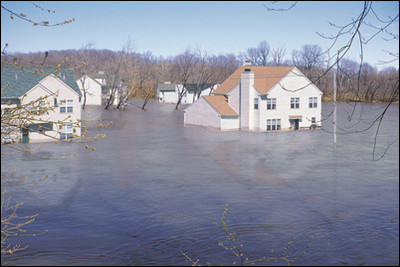I’ve learned that it doesn’t matter where you live—in a disaster-prone region or not—evacuations happen. This week, in our tiny Vermont area, it was a derailed gas car. Obviously, as I write, in Southern California it’s the wildfires. In coastal regions, it’s hurricanes. No matter what the emergency, people need to be prepared. I’ve looked at various sites that give advice on how to prepare for evacuations, and the guidelines are pretty simple. The message: We all need to be prepared.
The very first thing you need to know is whether you have time to make preparations or if your evacuation is immediate. Now, long before you are asked to leave, make sure you know your evacuation routes and what media outlets you will turn to for updates and information. Never, ever take a shortcut if you are evacuated because those routes may be blocked. If you have time, secure your home by unplugging all electrical equipment except freezers and refrigerators, unless there is a risk of flooding. If you need to gather disaster supplies, do so. Check out our article, “Assembling Your Disaster Kit”. Your best option is to have disaster supplies on hand and ready in case of a rapid evacuation. These supplies include key banking information, prescriptions and medical supplies, water and sturdy clothing. Keep a full tank of gas in the car as gas stations may be closed or empty. Have a battery-powered radio on hand. Let people know where you will go in case of an emergency and make plans with friends or relatives who can provide you with a safe place to stay. For more information, look at the Red Cross, FEMA or FLASH web sites. It makes sense for all of us, no matter where we live.
Categories
- Blog
- Accessibility
- Appliances
- Architecture
- Attic
- Basement, Foundation & Crawlspace
- Bathroom
- Bedroom
- Blog – Season 01
- Blog – Season 02
- Buying
- Cabinetry
- Carpentry
- Charity
- Cleaning
- Closets & Storage
- Codes & Legislation
- Contest
- Deck, Porch & Patio
- Decor
- Demolition
- Doors
- Driveway & Walkway
- Electrical
- Energy Efficiency
- Entertainment Room
- Entryway
- Events
- Exterior Features & Spaces
- Fitness & Recreation Room
- Floors
- Garage
- Green Building
- Hardware Tools
- Healthy Home
- Hiring a Pro
- Home Design
- Home Lighting
- Home Office
- How To
- HVAC
- Innovative Technology
- Inspecting
- Kitchen
- Laundry
- Lawn & Garden
- Living Spaces
- Masonry & Paving
- Paint & Wallpaper
- Pest Control
- Plumbing
- Real Estate
- Recycling
- Renewable Energy – Solar Biomass Wind
- Repairing
- Restoring
- Roofing
- Safety
- Seasonal
- Security
- Sheds & Outbuildings
- Siding
- Special Features
- Stairs
- Thomas J. MacDonald
- TV Show Tours
- Walls & Ceilings
- Weatherizing
- Windows
- Woodworking Industry
- Workshop
- Gallery
- Appliances
- Bathroom
- Cabinetry
- Closets & Storage
- Deck, Porch & Patio
- Electrical
- Energy Efficiency
- Exterior Features & Spaces
- Fitness & Recreation Room
- Floors
- Garage
- Green Building|Gallery
- Home Design
- Home Lighting
- HVAC
- Innovative Technology
- Kitchen
- Lawn & Garden
- Masonry & Paving
- Plumbing
- Real Estate
- Roofing
- Safety
- Seasonal
- Sheds & Outbuildings
- Siding
- Sunroom
- Travel Events Gallery
- Home Improvement
- HowTo
- 101
- Accessibility
- Appliances
- Architecture
- Basement, Foundation & Crawlspace
- Bathroom
- Bedroom
- Cabinetry
- Carpentry
- Cleaning
- Closets & Storage
- Deck, Porch & Patio
- Decor
- Demolition
- Doors
- Driveway & Walkway
- Electrical
- Energy Efficiency
- Entryway
- Fitness & Recreation Room
- Floors
- Framing
- Garage
- Green Building
- Hardware Tools
- Healthy Home
- Hiring a Pro
- Home Design
- Home Lighting
- HVAC
- Innovative Technology
- Inspecting
- Kitchen
- Lawn & Garden
- Living Spaces
- Masonry & Paving
- Paint & Wallpaper
- Pest Control
- Plumbing
- Real Estate
- Renewable Energy – Solar Biomass Wind
- Repairing
- Restoring
- Roofing
- Safety
- Seasonal
- Security
- Sheds & Outbuildings
- Siding
- Special Features
- Stairs
- Step-by-Step
- Sunroom
- Walls & Ceilings
- Weatherizing
- Windows
- Projects
- Step By Step
- Appliances
- Bathroom
- Cabinetry
- Carpentry
- Cleaning
- Closets & Storage
- Deck, Porch & Patio
- Doors
- Driveway & Walkway
- Electrical
- Energy Efficiency
- Floors
- Garage
- Hardware Tools
- Home Lighting
- HVAC
- Lawn & Garden
- Masonry & Paving
- Paint & Wallpaper
- Plumbing
- Roofing
- Safety
- Seasonal
- Siding
- Walls & Ceilings
- Weatherizing
- Windows
- Workshop
- Tips
- Accessibility
- Appliances
- Attic
- Basement, Foundation & Crawlspace
- Bathroom
- Bedroom
- Buying
- Cabinetry
- Carpentry
- Cleaning
- Closets & Storage
- Deck, Porch & Patio
- Decor
- Demolition
- Doors
- Driveway & Walkway
- Electrical
- Energy Efficiency
- Entertainment Room
- Exterior Features & Spaces
- Floors
- Framing
- Garage
- Hardware Tools
- Hiring a Pro
- Home Design
- Home Lighting
- Home Office
- HVAC
- Kitchen
- Lawn & Garden
- Living Spaces
- Masonry & Paving
- Paint & Wallpaper
- Pest Control
- Plumbing
- Real Estate
- Recycling
- Roofing
- Safety
- Seasonal
- Sheds & Outbuildings
- Siding
- Special Features
- Walls & Ceilings
- Weatherizing
- Windows
- Workshop
- Videos




























